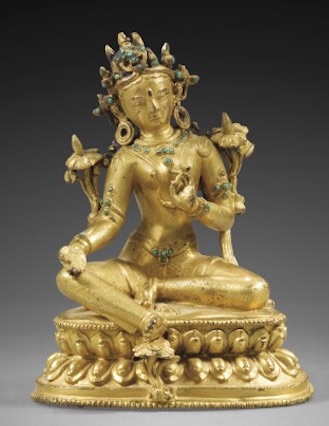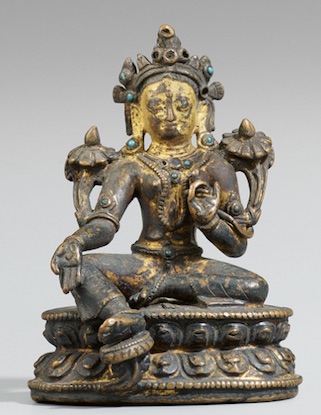
Circa 14th century, Tibet, Nepalese schools, Tara, copper with traces of gilding, turquoise, lapis lazuli, rock crystal, on a gilt copper repoussé base, 29,5 cm, photo: courtesy of Ulrich von Schroeder, Buddhist Sculptures in Tibet Volume Two, Visual Dharma Publications, Hong Kong, p. 966 pl. 233A, at the sMin grol gling (Mindroling) monastery (Tibet).
Green Tara holding a small round object in her right hand and making the gesture to bestow refuge (tip of ring finger on tip of thumb) with the other. A flower was once attached to her left elbow.

Circa 15th century, Tibet, Nepalese schools, Tara, gilt copper, 49 cm, photo as before (p. 967 pl. 233B), at the Shalu monastery (Tibet).
With her right hand in the boon-granting gesture and the other making the gesture of debate.

Circa 15th-16th century, Tibet, Tara, gilt copper alloy with stones, 9,5 cm, private collection, Fine Asian Works of Art lot 320, 17th December 2018, Bonhams (San Francisco).

16th century, Tibet, Tara, copper alloy, size not given, photo 36 on wisdomlib, at the Patan Museum (Nepal).

18th century, Tibet, Tara, copper alloy, size not given, photo on wisdomlib, at the Patan Museum (Nepal).
Seated on a double-lotus base decorated with an elephant next to the flower that supports her right foot.

18th century (Tibet?), Tara, bronze (with remains of gilding), 10 cm, Northern Himalayan Section photo 40, on wisdomlib, at the National Museum of Nepal.
Although labelled ‘Saptalochani Tara’ (Sitatara/White Tara), this is Green Tara, who has a green body on paintings and always sits with a leg pendant.

18th century (Tibet?), Arya Tara, bronze (with remains of gilding), 19 cm, Northern Himalayan Section photo 41, on wisdomlib, at the National Museum of Nepal.
Arya Tara is the name given to Syamatara/Green Tara in Nepal.




























































